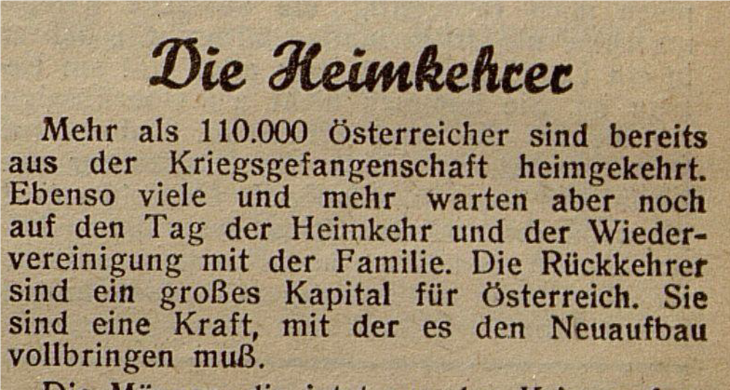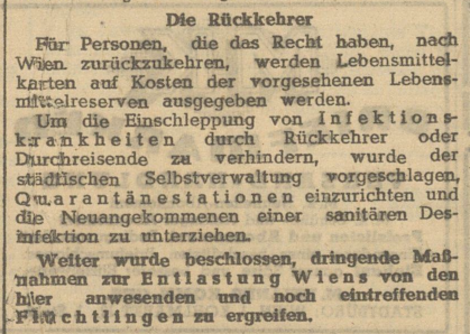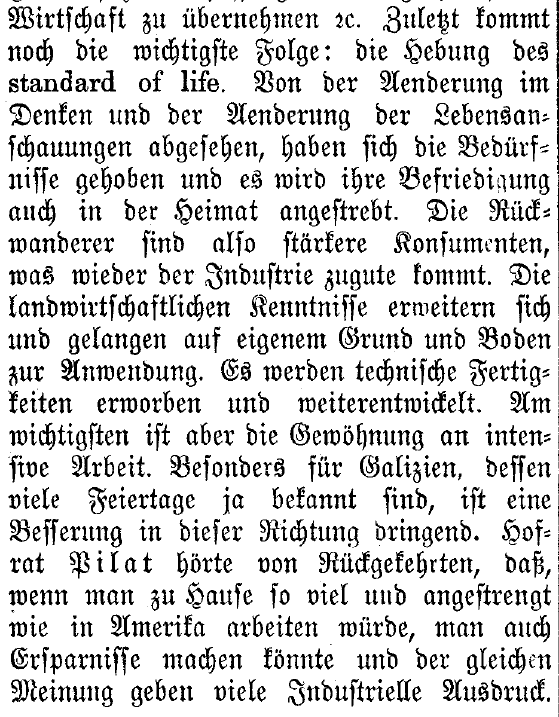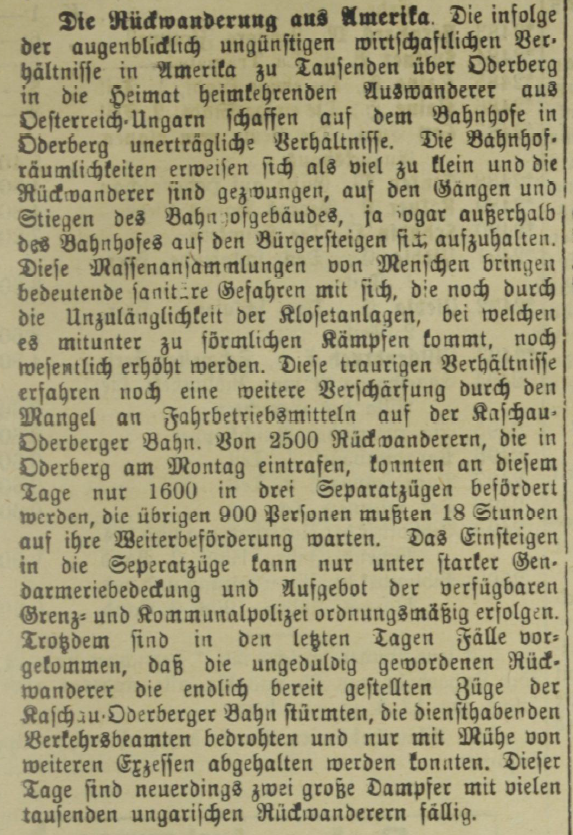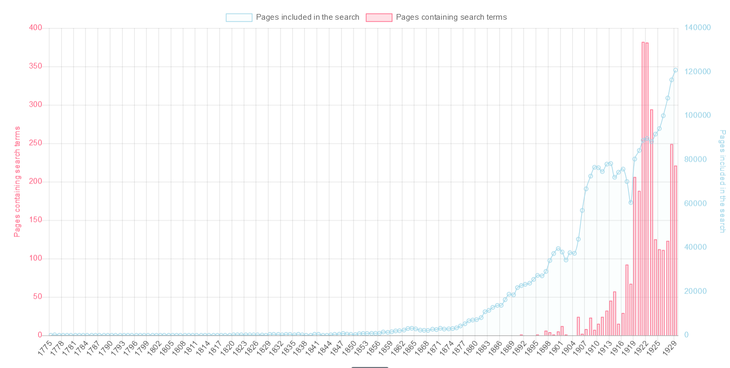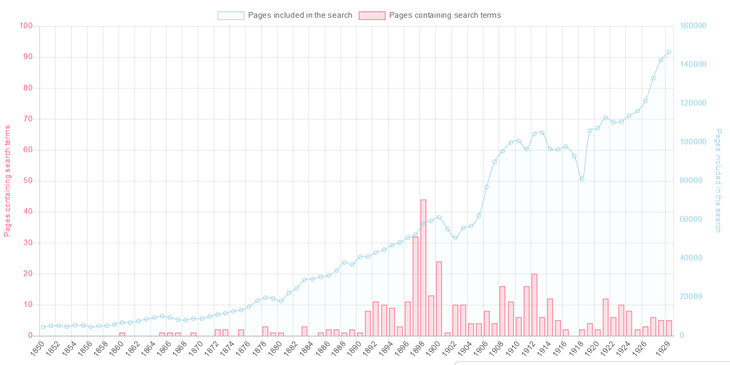By Dr. Sarah Oberbichler, University of Innsbruck
More than 50 million Europeans left their homeland voluntarily for overseas destinations between the Napoleonic Wars and the depression of the 1930s to seek a better life. In addition, there were involuntary emigrants such as prisoners of war or deported people as well as (war) refugees (esp. after the First and Second World War). No official numbers exist, but a significant amount of these voluntary and forced emigrants returned to their country of origin. Return migration, defined as the movement of emigrants back to their homelands to resettle, is therefore an important but often neglected aspect of the history of migration.
But not can emigration, be voluntary, so too can return migration; or forced (repatriation, deportation, or banishment). Every person who emigrated voluntarily and later decided to come back to their homeland had their own reasons: success, failure, homesickness, rejection of the new country, or perhaps family members asked them to return. For involuntary emigrants, some reasons may have been similar, but their return was often supported by the country of origin. However, the voluntary or forced remigration of emigrants not only leaves its traces on every person, but also in the country of return and its inhabitants. Newspapers can reveal how returnees were perceived in their countries of return and this is what I wanted to investigate. The steps for this were taken as below, starting with my research questions.
Research questions
- Are there changes over time?
- Do newspapers describe return migration as a positive or negative process and are there significant changes between returnees who voluntarily or involuntarily left their homeland?
- What types of returnees (refugees, prisoners of war, voluntary emigrants etc.) as well as nationalities, countries, and topics occur in the news coverage on return migration?
- How can I avoid hits that have nothing to do with return migration? For example, the word “Rückwander*” can be also be found in other contexts, like “the return (Rückwanderung) from the mountain tour”.
Keyword search in ‘ANNO’ of the Austrian National Library
After defining the research questions, I tested the existed tools of ‘Anno’. ‘Anno’ allowed me to do simple keyword searches as well as advanced searches with more keywords in a specific word distance. This are some of the results:
Simple keyword search: rückwander* (6.905 hits) (return emigrant); Heimkehrende* (43.919) (home comer); Heimkehrer (20.678) (returnee);
Advanced Search: “heimat rückkehr”~20 (11.868 hits) (return home); “heimat zurückkehren”~20 (12.189 hits) (return home); “flüchtlinge rückkehr”~20 (3.558 hits) (refugees return); "heimat zurückgekehrt"~20 (11.522 hits) (returned home); “emigranten rückkehr”~20 (1.122 hits) (emigrants return); "Österreich rückkehr"~20 (8.897 hits) (Austria return); “Juden rückkehr”~20 (1.174 hits) (Jews return); “auswanderer zurückkehren”~20 (359 hits) (emigrants return); “fremde rückkehr”~20 (1.240) (foreign return);
Keyword search in ‘DIGI’ of the National Library of Finland
Jani Marjanen, researcher at the University of Helsinki, tested the existing tools of ‘DIGI’. This are some of the results:
Simple keyword search: Kotiinpaluu (3.212 hits) (repatriation); Takaisinmuutto (moving back) (27 hits); Återvända (210.979) (return); “hem(w/v)andring” (78 hits) (home coming);
Advanced search: Concordances relating to ‘kotiinpaluu’ (repatriation) gives as ad hoc corpus of 48 744 total words and 18 060 unique word forms (the large amount of unique words comes from OCR errors). Most frequent words in the corpus are (excluding stop words) pakolaisten (397 hits) (refugees); suomen (149 hits) (Finland’s); karjalan (148 hits) (Carelia’s); jääkärien (141 hits) (Jäger pl.); inkeriläisten (Ingrians’) (121 hits);
A search on “emigration” (emigration) and “återvända” (return) within 20 words of each other yielded 393 results for the period 1850-1929. This search seems to be very good for tracing qualitatively interesting articles. There is also a clear peak at the end of the 1800s:
Conclusions from both search queries and results show that:
- Many of the results from the simple search have nothing to do with “return migration”.
- It is hard to say how many articles show up twice or more often.
- It was difficult to find keywords related to “return migration”.
- It was not possible to find newspaper clippings showing positive or negative aspects.
- It was difficult to find keywords that describe positive or negative moods.
- We got less or wrong results due to incorrect text recognition.
- ‘Anno’: The search with asterix (*) works with simple keywords but not with an advanced search.
- ‘Anno’: The advanced search does not really work with three or more keywords.
So the question is how can NewsEye make a real difference?
NewsEye will improve the existing methods and functions and add tools that allow a dynamic analysis of newspaper articles. Right now, there is no way to find important topics as well as thematic changes within the discourse of ‘return migration’ in a reasonable timeframe. With the existing tools, it is not possible to say when ‘return migration’ is described as a positive or a negative process without reading all articles. Tools that provide keyword or article suggestions will help to find relevant articles faster and the exclusion of irrelevant articles will make the research more effective.
What tools can NewsEye provide to answer the research questions in an appropriate timeframe?
After testing the existing tools, we made a list of methods and functions we need for further investigations:
Tools for analysis: Keyword Search, Sentiment Analysis, Topic Modelling, Exclusion of non-relevant Articles, Exclusion of Duplicates, Manual Annotation, Named Entities, Co-occurrence Analysis, Keyword Suggestions, Article Suggestions, Thesaurus Suggestions, Linking to External Resources/Reference Material, Citation Suggestions for different Citation Styles, Metadata about Cited Material (newspaper background, also possible as crowd created content)
Tools for analysis and visualization: Frequency Analysis (distribution of words), Mapping (georeferencing), Network Analysis exploring relationships and connections), Word-clouds
What research results regarding ‘return migration’ can be expected after the first investigations with existing tools?
Based on this first research, following results can be expected. In a next step, the hypotheses will be proved with new tools and functions from NewsEye:
The news coverage of returnees shows positive as well as negative aspects of return migration. In some cases, returnees were expected and welcomed. They were seen as helpful workers and important capital for the country of origin (political instrumentalization, brain drain etc.). On the other hand, returnees were perceived as a burden (because of reduced living space, work, and resources etc.) It can be assumed that newspapers more frequently reported about positive aspects. It can also be expected that newspapers more frequently reported on returnees who emigrated involuntarily than voluntarily. The following newspaper clippings show, for example, how different the return of refugees was described in 1945/46 or 1907/1908.
Hover over the images for an EN translation.
